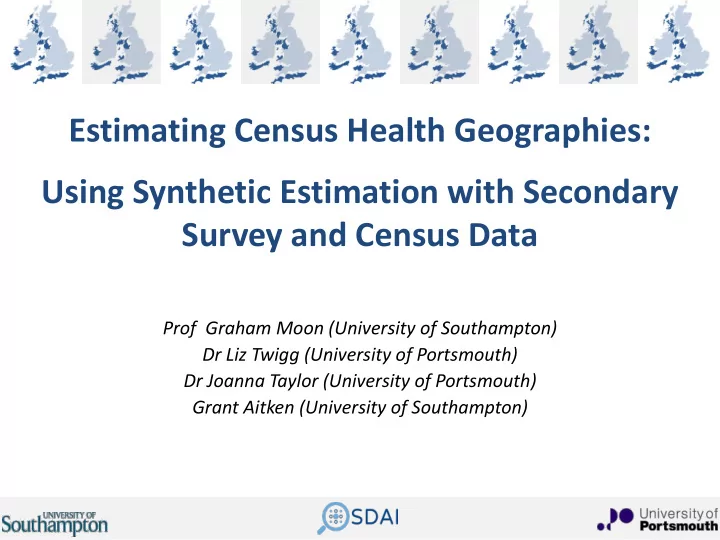

Estimating Census Health Geographies: Using Synthetic Estimation with Secondary Survey and Census Data Prof Graham Moon (University of Southampton) Dr Liz Twigg (University of Portsmouth) Dr Joanna Taylor (University of Portsmouth) Grant Aitken (University of Southampton)
Today’s presentation Background Project aims Methodology Results Policy implications Past and current applications Further information
Background Small area health information highlights localised need for health services and community based care provision. Such information… “ can be a powerful vehicle for improving the health of a community by both highlighting the existence of problems and opportunities for improvement. It can also guide local action in support of policy change ” (Luck et al, 2006, 979). Direct small area estimates of health related behaviours and outcomes seldom available from social surveys due to insufficient sample sizes. Here we focus on ML-SASE as a method for bridging this information gap
ML-SASE “modelling nationally, predicting locally”
Background The validation of synthetic estimates has always been problematic due to the fact that there is hardly ever any robust localised data to compare the synthetic estimates against – indeed if such data existed there would be no need for synthetic estimates! However, by generating small area estimates of the census questions on health has provided us with the opportunity not only to further assess synthetic estimation as a methodology for generating small area data on health related behaviours and outcomes, but also to develop and extend the multilevel small area synthetic estimation methodology . 2011 Census health questions … Self assessed health Carer responsibilities Limiting long term illness
Surveys used to source health questions The Annual Population Survey The Integrated Household Survey The Crime Survey for England and Wales The Health Survey for England The Scottish Health Survey The Welsh Health Survey All well established, regular, large, well designed health or social surveys
Other data sources used in the modelling process The Indices of Multiple Deprivation DWP data on claimant counts At the individual level age and sex from the census
Results Severely limiting long term illness Limiting long term illness but not severely Multinomial model No LLTI
Results Same conclusion as ONS (who used a different synthetic estimation methodology) … Further work needed to determine why it is more difficult to estimate this indicator Important predictors are unavailable routinely Unpaid care
Results contd. Other methodological extensions: Incorporating geodemographic classifications into the estimation process (on-going) Tested the importance of geo-coded (i.e. spatially referenced) social survey datasets. Identified continued discrepancies over question wording.
Policy implications We recommend that geocoded social survey datasets should be seen as the ‘gold standard’ for all surveys deposited with the UK Data Service. Estimates provide expected values (of population-level need) – c.f. service-related use data. ML-SASE can provide inter-censal data. Need to harmonise census and survey questions.
Other policy areas (1) Current Smokers Obesity
Other policy areas (2) Chronic Kidney Disease Core Volunteering
Impact We are working with NICE and Public Health England to generate multilevel synthetic estimates of youth smoking. We delivered a two day training course at GGD Amsterdam for the public health service of the Netherlands. Work continues to develop small area synthetic estimates of health related behaviours across the Netherlands.
Training day on synthetic estimation
Training day on synthetic estimation
www.synthetic-estimation.moonfruit.com
Recommend
More recommend